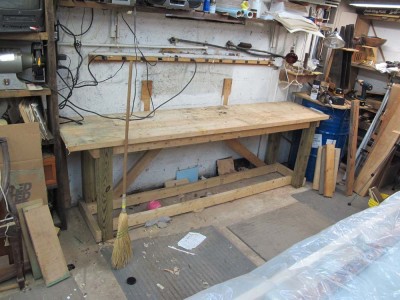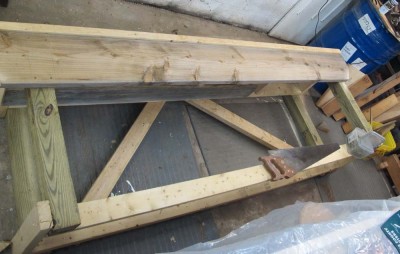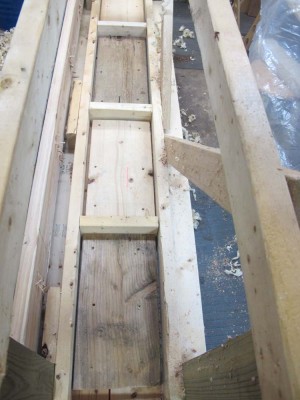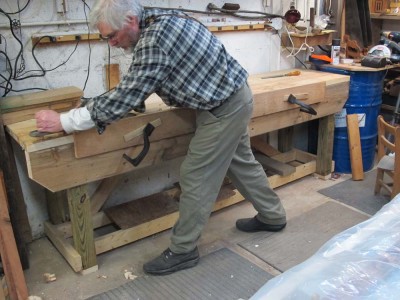The 80-Minute Nicholson Workbench
Like many in the woodworking universe, I am a benchaholic. We revel in the design, construction and use of exquisitely elegant workbenches: Roubo, Nicholson, torsion boxes, Moravian, Scandanavian, etc. Sometimes I fear that our fascination with these remarkable tools can be off-putting to those who are just starting out in furniture making, or at least do not yet have such-and-such a bench. I have spoken with folks who tell me something like, “Well, I would like to begin serious woodworking but I’ll have to wait until I get the time I need to build a (fill in the blank) bench.”
I’m probably guilty of promulgating this mythology to some degree, as I have waxed ecstatic about this or that response to workbench design, building, or using. If I have done so and you have found it a hurdle to your work, I apologize sincerely.
Two recent developments for me have been a brisk wake-up call. First was watching Mike Siemsen’s brilliant video “The Naked Woodworker,” which is now part of the ensemble of references I steer all new woodworkers towards (along with “The Anarchist’s Tool Chest” and James Krenov’s “A Cabinetmaker’s Notebook”) and the companion Siemsen youtube video on using the bench he builds in the video. Folks, they are solid gold. Mike is such a down-to-earth guy that his persona often inadvertently obscures his own giftedness at the workbench.
Second has been the recent revival of my own conservation projects, some of which are taking place in my old studio in my daughter’s house basement (which has been nothing short of total dishevelment for the past year). Of course, when I transferred the contents of my workshop from there to the barn, I left myself with only the barest of bones regarding tools and supplies necessary for maintaining a house, not for building or restoring furniture. Among the voids in the space was the hole left by the workbench that is no longer there. Increasingly I found myself frustrated by not having any real workbench to use.
With Mike’s inspiration fueling me, I took a new look at my workspace and the assets there. No, I did not have a workbench, but I did have this crude work-table along the wall. Built after supper one night several years ago, its only real function to this point was to hold stuff. I had a Zyliss vise on it, and it served my needs for the tasks of house-work.
Today these needs and Mike’s inspirations prompted me to retrofit this table, making it into a spare but fully-functional Nicholson bench. The best part of the whole venture was that it took only about 80 minutes of work to accomplish the transformation, using a couple of boards from my stash in the lean-to shed. Cleaning the bench off took nearly as long as the new construction.
I first laid down the old table on it back and screwed a 10-inch wide apron on the front. Ideally I would have used a 12-inch wide apron, but there wasn’t a 2×12 out in the shed. So, with my battery drill and decking screws a new apron was in place. The step of planing the top overhang to be even with the apron surface took the most time of the whole project, and was really an unneccessary step had I been building this from the start. But I wasn’t, so I had to plane off 1/4″ of excess overhang. I suppose I could have sawn it, but I just set up the fore plane to cut pretty aggressively and knocked it out.
I added a 2×8 backing board behind the apron to allow for use of holdfasts, which are the key to the use of a Nicholson-style bench. I drilled a dozen holes for holdfasts on the front then flipped the bench onto its top.
While upside-down I took some 2×10 scraps and screwed them to the underside of the 2x top, for the same purpose as the skirt backing board – it allowed the utilization of holdfasts. Also while it was upside down I screwed new 2×4 skids under the legs to raise the bench height a little. I prefer my workbench height to be taller than a lot of folks, to be even with the top of my wrist while my arm is hanging down, it’s just the way I work most comfortably.
After turning the unit back into its upright stance, I drilled holes in the top for holdfasts.
Then I got to work. I still need to install a crochet on the apron and a planing stop through the top, but for now I need to get back to my projects.
Even if you count the time I spent construction the original table, at this point I have a simple and highly functional woodworking workbench for less than three hours (!) and a few pieces of wood from the shed. Now I’m trying to figure out how to make the presence of this bench a “selling point” if this house ever goes on the market.








Join the Conversation!